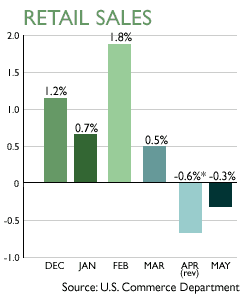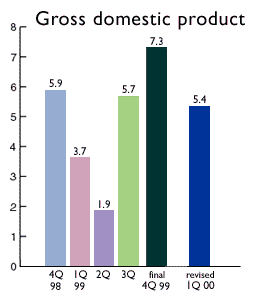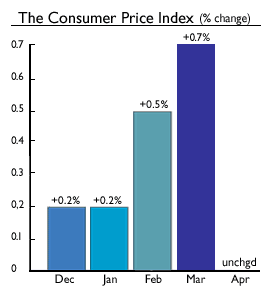|
Retail sales fall again
|
 |
June 13, 2000: 2:20 p.m. ET
May sales decline 0.3% in second monthly drop; ex-autos unchanged
By Staff Writer M. Corey Goldman
|
NEW YORK (CNNfn) - U.S. retail sales fell for a second straight month in May, the government reported Tuesday, fueling expectations that the economy may be slowing to a more sustainable pace that will spur the Federal Reserve to hold the line on raising interest rates.
 Retail sales declined 0.3 percent last month, the Commerce Department said, compared with a revised 0.6 drop in April. It was the first time since July 1998 that sales fell two months in a row. Sales of big-ticket durable goods, which are more sensitive to changes in interest rates because they usually are financed, dropped for a third straight month. Retail sales declined 0.3 percent last month, the Commerce Department said, compared with a revised 0.6 drop in April. It was the first time since July 1998 that sales fell two months in a row. Sales of big-ticket durable goods, which are more sensitive to changes in interest rates because they usually are financed, dropped for a third straight month.
The report fueled optimism that the U.S. economy, now in its 110th month of uninterrupted growth, may be slowing down -- diminishing the urgency for the Federal Reserve to raise interest rates further to slow spending and ward off inflation. Fed officials meet June 27-28 to debate their next move, if any, on rates.
"For the past six months we've all been wondering when consumers would come back down to earth from their stratospheric orbit," said David Orr, chief economist with First Union National Bank. "It looks like it's finally happened."
The latest sign of a slowdown
Indeed, the weaker-than-expected report is the latest in the past month indicating slower activity, particularly among consumers. Other reports have shown faltering job growth, slower manufacturing output, stagnating wages, subdued spending, and slowing home sales. Consumer spending accounts for about two-thirds of U.S. economic activity.
 Lynn Reaser, chief economist with Bank of America Asset Management Group, told CNNfn's Before Hours that Tuesday's retail report is more proof that the economy is responding to the Fed's series of rate increases over the past year -- enough to ensure that the Fed's policy arm leaves rates unchanged later this month. (347KB WAV) (347KB AIF) Lynn Reaser, chief economist with Bank of America Asset Management Group, told CNNfn's Before Hours that Tuesday's retail report is more proof that the economy is responding to the Fed's series of rate increases over the past year -- enough to ensure that the Fed's policy arm leaves rates unchanged later this month. (347KB WAV) (347KB AIF)
Bonds initially gained ground and the dollar fell against major currencies as investors concluded the Fed likely is less likely to raise rates later this month. Later they retreated after remarks from a Fed official suggested the central bank may not yet be finished with its series of interest rate increases. Stocks registered little reaction to the numbers, with both the Dow Jones industrial average and Nasdaq composite index falling in early trading. Both indexes recovered by late afternoon.
"There is no question that the economy is slowing, but it's not exactly shrinking, either," said Michael Gregory, vice president and chief economist with Lehman Brothers Inc. "We are seeing the first tentative signs of slowing, but you have to remember that we are starting at a very high base of growth. The Fed will still err on the side of caution and restraint."
Not over just yet
The U.S. economy advanced at a 7.3 percent pace in the fourth quarter of 1999, then slowed slightly to a 5.4 pace in the first quarter of 2000, according to revised figures released by the Commerce Department last month. The second-quarter numbers will be tallied at the end of June, with preliminary data being released sometime in July.
Of course, it's not a given that the Fed will call off the dogs immediately.
 For one thing, renewed gains among both technology and blue chip stocks likely will rekindle concern about the "wealth effect," in which rising stock values make Americans feel good about spending money. While nowhere near the levels seen at the beginning of the year, when both the Dow and Nasdaq hit record highs, at least part of the paper wealth shed by the recent downturn has been recovered in a modest rally. For one thing, renewed gains among both technology and blue chip stocks likely will rekindle concern about the "wealth effect," in which rising stock values make Americans feel good about spending money. While nowhere near the levels seen at the beginning of the year, when both the Dow and Nasdaq hit record highs, at least part of the paper wealth shed by the recent downturn has been recovered in a modest rally.
What's more, falling government bond yields and the declining value of the U.S. dollar against other major currencies -- a direct result of investor expectations that official rates won't rise any higher -- also may spur the Fed to take action. On the bond side, lower yields encourage businesses to borrow at cheaper rates, fueling inflation. On the dollar side, a weaker currency encourages international buyers to stock up on U.S.-made goods.
And, Gregory said, time may not necessarily be on the Fed's side. With about two months between the June meeting and the August meeting, "the Fed is going to want to take the more cautious road. Two months is an awful long time to wait to react to evidence, particularly if that evidence indicates the economy is starting to heat up again."
Consumer price report awaited
To determine whether strong economic growth is fueling an acceleration in prices for goods and services, analysts and investors will be looking at May's consumer price index report, due for release from the Labor Department on Wednesday.
 Analysts polled by Briefing.com anticipate that prices at the retail level advanced at a 0.2 percent pace last month. Excluding volatile food and energy costs, prices are expected to have risen at the same 0.2 percent pace, according to forecasts. Analysts polled by Briefing.com anticipate that prices at the retail level advanced at a 0.2 percent pace last month. Excluding volatile food and energy costs, prices are expected to have risen at the same 0.2 percent pace, according to forecasts.
Fueling May's decline in retail sales was a drop in car sales, which fell 1.3 percent after falling 1.2 percent the previous month. Americans also spent less on clothing and dining out last month, the report said. Several of the nation's larger retailers reported mixed sales last month, due partly to rising rates that have deterred consumers from spending.
Other declines included sales of building materials, which fell 1.6 percent, and sales of furniture, which declined 0.3 percent. Sales of durable goods -- items such as appliances and electronic equipment built to last at least three years -- fell 1 percent in May after a 1.2 percent drop in April.
Partially offsetting the overall declines were higher gasoline prices. The dollar value of May sales at gasoline service stations rose 0.3 percent. Sales of non-durable goods rose 0.2 percent following a 0.1 percent decline. 
|
|
|
|
|
 |

|

